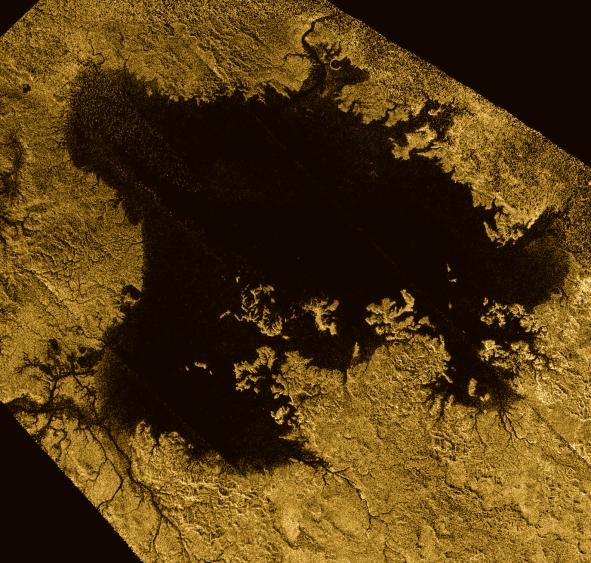New Scientist | Astrophile | Lisa Grossman | 2013 Oct 18
Objects: Titanic wetlands
Likely source: Subsurface wells of hydrocarbons
The other meteors in the solar system were so lucky. They landed on nice, hard rock like on Mars or Mercury, exploding on the surface and excavating deep craters. If I had followed their lead, I could have left my mark! But no, I headed straight for this orange haze-ball Titan and plopped down in the northern marshes. I was a mere splash in an icy puddle, and all evidence of my existence was erased.
- [url=http://solarsystem.nasa.gov/multimedia/display.cfm?Category=Planets&IM_ID=16706][b][i]Ligeia Mare[/i][/b][/url][i], shown in this false-colour image from NASA's Cassini probe, is the second-largest known body of liquid on Titan and it is filled with liquid hydrocarbons, such as ethane and methane. [b](Credit: NASA/JPL-Caltech/ASI/Cornell)[/b][/i]
So was the fate of many a meteorite that struck Saturn's largest moon, according to a new analysis of Titan's topography. The work suggests that large, crater-free bands bordering the moon's equator are wetlands fed by subsurface springs, where any incoming meteors would have made more of a splash than a bang. Those same springs may be the source of Titan's polar lakes, feeding the world's unusual liquid cycle.
Among the many moons in our solar system, Titan is the most eerily Earth-like. It is the only other solid body to host a thick atmosphere and to have rainstorms, rivers and lakes. But unlike Earth, chilly Titan's liquids are methane and ethane. Titan also neatly divides its surface features into horizontal bands. The poles are covered with hydrocarbon lakes and boast few craters, while the equator is a vast dune field peppered with impact scars. The mid-latitudes are nearly featureless expanses, dubbed the Bland-lands.
"The complete lack of craters near the poles… People have noticed this for a while, but nobody's had any good explanations," says Catherine Neish of the Florida Institute of Technology in Melbourne. She wondered if craters there are simply melting away because the meteorites are landing in vast hydrocarbon swamps.
High and dry
On our home turf, craters that form in shallow seas or wetlands hardly make an imprint in the soggy ground and are quickly subsumed. "The wet sediment slumps back into the crater and basically fills it in, so you get a pretty flat crater even to start with," says Neish. The best way to identify submarine craters on Earth is with drilling or seismic surveys. "But if all you have is remote sensing data, it might be difficult to identify something as subtle as that."
If Titan's craters are being swallowed by soggy ground, then the ones we do see should appear more often at higher elevations, where the ground would be drier. To test this idea, Neish and her colleague Ralph Lorenz at the Johns Hopkins University Applied Physics Lab in Laurel, Maryland, examined a new map of Titan made from radar readings by NASA's Cassini orbiter, published earlier this year.
"It's the first global topographic map of Titan that's ever been made," says Neish. "This is the first chance to really explore this issue quantitatively, instead of just qualitatively." The team found that, statistically, more craters do exist at higher elevations all across the globe, while low zones have far fewer. The pair then went over alternative explanations for the distribution pattern, such as erosion by wind or burial under material flowing from ice volcanoes.
"In this paper I went through all the possibilities I could think of," says Neish. "None of them made sense, except that the mid-latitudes are or were recently extremely wet and that craters are there; we just can't see them."
Hidden sea
The presence of underground aquifers could explain another mystery. Titan's atmosphere is full of methane, which should react with ultraviolet radiation from the sun to produce liquid ethane. Over time, the moon should have built up an ethane ocean hundreds of metres deep. But when the Cassini probe arrived at Titan, it found only the polar lakes. "So where did all the ethane go?" says Neish. The presence of wetlands would suggest that it soaked into the ground, forming a subsurface liquid layer akin to groundwater on Earth.
"This is an important question," says Cassini team member Jonathan Lunine at Cornell University in Ithaca, New York, who was not involved in the new work. "We know that methane can't last over the age of the solar system. Unless we're looking at an unusual time in Titan's history, there must be a methane resupply mechanism. Anything we can do to figure out how much methane or ethane is in the crust is important."
He thinks the wetlands proposal is an interesting hypothesis. The next thing to do, he says, is get more radar data. "It's sobering to think we have just a little bit more than half of Titan mapped now with Cassini radar, which is the highest resolution data," he says. "Titan's dense atmosphere just makes everything more difficult. But Cassini is getting there."
Elevation distribution of Titan’s craters suggests extensive wetlands - C.D. Neish, R.D. Lorenz
- Icarus 228(1) 27 (15 Jan 2014) DOI: 10.1016/j.icarus.2013.09.024
Cassini Shapes First Global Topographic Map of Titan
NASA | JPL-Caltech | Cassini Solstice Mission | JHU-APL | 2013 May 15
A global topographic map of Titan - Ralph D. Lorenz et al
- Icarus 225(1) 367 (July 2013) DOI: 10.1016/j.icarus.2013.04.002
Cassini Gets New Views of Titan's Land of Lakes
NASA | JPL-Caltech | Cassini Solstice Mission | CICLOPS | 2013 Oct 23
<< Previous Astrophile

